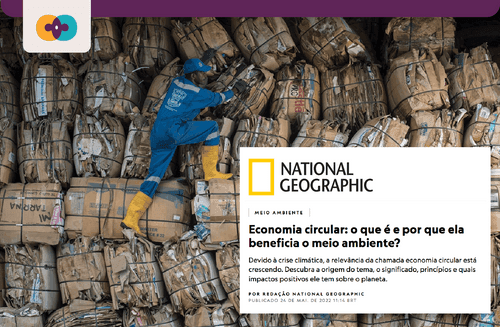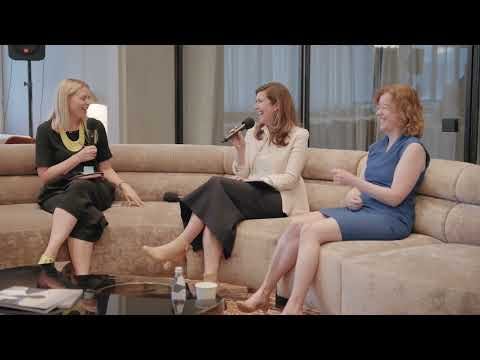
27/05/2022
Circular Movement in National Geographic
See what an incredible space we have achieved! The Circular Movement served as a reference in a National Geographic news piece, published last May 24. The magazine interviewed the Movement's Pedagogical Coordinator, Professor Dr. Edson Grandisoli, along with the director of the Ellen MacArthur Foundation for Latin America and the Caribbean, Luisa Santiago. Below is the full article:
Circular Economy: what is it and why does it benefit the environment?
BY NATIONAL GEOGRAPHIC. POSTED MAY 24, 2022 11:14 BRT
Due to the climate crisis, the relevance of the so-called circular economy is growing. Find out the origin of the topic, its meaning, principles and what positive impacts it has on the planet.
Featured photo credit: Thomas Peschak/ National Geographic
Linear models are exposed to price fluctuations and access to raw materials and contribute to environmental degradation, affecting ecosystem services essential for development. On the other hand, the circular model is restorative and regenerative, and aims to keep products, components and materials in greater utility and value.
By returning what would have been discarded as trash to the production cycle, it is possible to reduce the quantity of raw material extracted from nature, which consequently reduces waste along the chain.
"By using fewer resources, you also reduce the need to transport these materials, which reduces the production's carbon footprint, since most transport still depends on oil-derived fuels,'' said Edson Grandisoli, a researcher on the Global Cities program, at the Institute for Advanced Studies at the University of São Paulo (IEA-USP), in an interview to the National Geographic.
But in addition to reducing waste production, the circular model uses waste as a source of wealth creation. For example, organic waste, such as fruit and vegetables, can be decomposed by composting to become fertilizers for agricultural production, which serves as food and protection against pests, reducing the use of chemical products in plantations.
The benefits, moreover, are quantifiable. A report by the United Nations Environment Program (UNEP) states that a circular economy model could reduce industrial waste in some sectors by 80-99%, and emissions by 79-99%.
What are the principles of the circular economy?
In a circular economy, economic activity contributes to the overall health of the system. That is why the model is based on three principles: eliminate waste and pollution from the outset, maintain products and materials in use, and regenerate natural systems.
"A circular system basically paves the way for some of the materials that are already in circulation, such as those that make up a mobile phone, for example, so that they can return to their initial point of production, thus preventing them from becoming waste", explained Grandisoli.
By increasing the useful life of existing materials, fewer natural resources are extracted for new products, less waste is produced, and consequently the environmental impact generated in linear economics is reduced.
This concept, also called crib to cradle, implies that there is no idea of waste and that everything serves continuously as food for a new cycle.
"The linear system systematically destroys nature, that is, we need to destroy it in order to generate economic value,'' said Luisa Santiago, director of the Ellen MacArthur Foundation for Latin America and the Caribbean in an interview with National Geographic. By contrast, in the circular economy, nature regenerates as economic value is generated. For Santiago, therefore, the third principle, that of the regeneration of natural systems, is the most important one for the region, due to the abundance of biodiversity.
The role of recycling in the circular economy
According to Santiago, the central approach is to think "how we can make the economy, through its project, regenerative".
Therefore, although reuse is at the center of the model, recycling is a final strategy that must be thought out and planned to be truly possible. She adds that recycling capacity should be a technical feature, but one that should be thought of in terms of a system.
"For between 40 and 50 years we've been talking about recycling and yet less than 20% of the products on the market are recycled. That is why it seems that the way it is dealt with is not an effective strategy", Santiago warned, pointing out that the future challenge is to treat this kind of concept from a systemic, and not linear, perspective.
"Designers play a key role in the circular economy," explains Grandisoli. ‘It is necessary to create products that can be easily dismantled and reused or recycled’.
For him, this is one of the most important and difficult parts of the systems for reusing material to be implemented. "In electronics, for example, there are less and less disassemble materials, and it is increasingly difficult to reuse parts or devices `offline'. Part of the blame lies in the fact that the products are designed to be disposed of quickly."
From a linear to a circular economy
The current linear economic system follows a path that begins with the exploitation of natural resources and continues with the production, consumption, and disposal, that is, with the end of the useful life of the products.
"This is the logic that capitalism has been following for 300 years. A story in which, every day, we extract an enormous amount of natural resources that are transported and transformed into consumer products that, at the end of the day, are discarded without being given new uses and that accumulate exponentially,'' explained Grandisoli, who is also the coordinator of the Circular Movement initiative, an organization that values the education and promotion of the circular model for consumers and companies.
In The Circular Economy: In a paradigm shift towards global solutions, experts Manuel Albaladejo and Paula Mirazo, from the United Nations Organization for Industrial Development (Onudi), and Laura Franco Henao, from the Ellen MacArthur Foundation, specified that to achieve the Sustainable Development Goals (SDGs) and the greenhouse gas emission commitments set out in the Paris Agreement, a new economic model must be adopted.
According to the publication, the economy has followed a pattern based on undefined extraction, production, consumption and disposal, without considering that the raw materials necessary to keep this system working may be exhausted.
"We are faced with a model which considers that nature is totally disposable and that the resources are infinite,'' says Grandisoli.
Grandisoli highlights the scarcity of natural resources and the accumulation of tons of waste in sanitary landfills, which contaminate the soil, the water and affect human health, as two of the main problems generated by the current model.
In Latin America and the Caribbean, the production of municipal solid waste reached 540,000 tons per day in 2018, according to a report by UNEP.
Roughly 145,000 tons (one third of what is generated daily) of garbage goes to open landfills or directly to the environment.
Circular Economy: where and when did the concept originate?
The idea of feedback and cycles in real-world systems is an old one that resurfaced in industrialized countries after World War II, "when computerized studies of non-linear systems revealed the complex, connected and unpredictable nature of our world, which is more like a mechanism than a machine," highlights the Ellen MacArthur Foundation website.
"In the 19th century there were already theorists who spoke of this notion", Santiago explains. "In the 20th century, around the 1970s, some schools of thought sprung up in different parts of the world that promoted the thinking and the concept of the circular economy."
According to the Foundation, these schools generally include the performance economy of Walter Stahel; the cradle-to-cradle design philosophy of William McDonough and Michael Braungart; the idea of biomimetics put forward by Janine Benyus; the industrial ecology of Reid Lifset and Thomas Graedel; the natural capitalism of Amory and Hunter Lovins and Paul Hawkens; and the blue economy approach, described by Gunter Pauli.
"The circular economy brings together all these ideas as strategies or methods for constructing an economic system that takes into consideration the flows of material and of financial capital", Santiago summed up.
Towards a definition
Although the concept is not new, the circular economy has gained ground in recent years. Scientific evidence has kept pace the need to modify the current model of production, distribution, consumption and disposal, whose very unviability is arousing a growing interest in more sustainable alternatives.
The Ellen MacArthur Foundation was established in 2010 to contribute to and accelerate the transition to the circular economy through networking amongst governments, business and academia in order to build a regenerative and restorative economy by project.
In 2015, the organization set foot in Latin America and the Caribbean to address the emerging model from a regional perspective.
"It is true that the circular economy has gained a lot of prominence. However, there is a lot of noise or confusion about what is really going on," says Santiago. "For example, the concept is used nowadays to refer to the economics of recycling, to the adequate management of waste, and even to conscious consumption."
However, it is clear that neither of these definitions is appropriate. According to her, the circular economy is an economic system, a structural solution for the transformation of the current system. The climate crisis and the loss of biodiversity are not symptoms, but a cause of "our linear way of producing and consuming products and materials".
The circular economy, therefore, "represents a structural solution and an opportunity to transform and replace this system by one that faces these great challenges", Santiago concludes.
A change in values
The existing circular economy models are mostly functional only on a small scale. Some companies or organizations can implement production lines that value sustainability and reuse. However, for the economic model to become truly sustainable, a global change of values is necessary, according to experts.
Grandisoli also emphasizes, for example, that for circular alternatives to really make a difference, the contemporary thinking of the individual about the collective needs to be put aside.
"The obstacles to a more sustainable economy must be overcome collectively. Isn't it worth thinking about giving up certain things and making greater gains on a collective level at a moment like this, when we are going through a crisis like this?" questions Grandisoli.
"This is the perfect moment for recovering economically", Santiago adds, "but looking at a new order of development, an era in which we have built upon the riches of our region a model that will lead us to prosperity in the long run."
Also read on the National Geographic website

